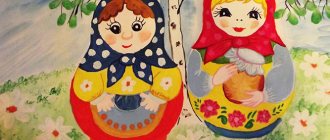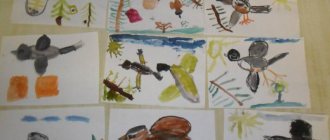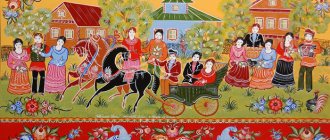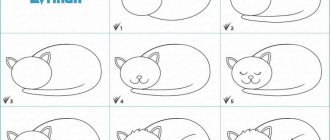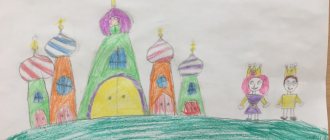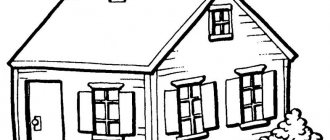What will you need for work?
- Paints are white and blue, shades of blue. For the first time, white and blue are enough. For painting you can use gouache, watercolor, acrylic.
- Brushes. Paint with flat synthetic brushes of different numbers. You can try No. 7, which gives a fairly large smear. Thin brushes are suitable for painting blades of grass and other elements.
- Stencils on which children will practice and perfect their strokes before painting dishes. They can be found on the Internet and printed, or taken from special publications. Wooden stencils work well - for example, this teapot. On the one hand, you can paint it according to the applied design, on the other, you can paint it yourself.
- Ceramic, clay, wooden or plastic tableware (plates, cups, saucers).
- Jars for water, simple oilcloth, paint removal wipes, clothing protection, etc.
How to make a stencil for Gzhel painting?
You can create stencils for painting any surface under Gzhel in different ways, depending on the main object.
For example, a bird should be done like this:
- Transfer a small amount of paint to the palette, then use a special spatula to stir the color.
- Dip a flat brush (it is recommended to use a figure eight) into the pigment so that on one side of the bristles the layer of paint is denser than on the other.
- Having distributed the paint over the pad of one of the fingers of the leading hand, make a stroke on the working plane in the shape of a semicircle.
- Using short strokes, draw the wings and the outline of the body.
- Draw the tail with wavy lines.
- Re-circle the wings, darkening their outline.
- Detail the image.
- Having refreshed the already dried lines, apply the stencil to the desired object, then remove the paper and finalize the ornament on the white surface.
Gzhel will be interesting for children only if they are familiar with the history of the creation of this painting. Realizing the versatility of this type of creativity, young artists will quickly master the basic algorithms for creating the simplest ornaments, which will allow them to begin independently developing patterns, as well as creating complex plot pictures.
Master class on drawing simple Gzhel patterns for children
In order for a child to be able to independently come up with Gzhel patterns, he should master how to create the simplest types of ornaments.
Sitchik
To create such a pattern, your child will need a brush with long, thin bristles.
It is recommended to draw a sitchik like this:
- Having first placed a small amount of paint on the palette, use a brush slightly moistened with water to pick up pigment on the tip.
- Using precise light touches of the working plane, draw several points on the working plane, placing them in a horizontal or vertical row, at a distance of 2-3 cm from each other.
- Wash off the remaining paint, and then apply a contrasting shade of pigment to the tip of the brush in the same way.
- Lightly touching the surface of the sheet, draw semicircles near the marked points, connecting them to each other at the extreme points.
- Clean the brush from any remaining paint, and then again pick up the pigment of the same shade as the semicircles depicted earlier.
- At a distance of 0.5 - 1 cm from the junction of the semicircles, place the required number of points created by lightly touching the paper with a brush. The density of these points should be approximately half that of the main ones drawn in step 2.
- Fill the working plane with the selected pattern or, if desired, combine 2-3 types of ornaments, while making sure that they do not intersect with each other and are all consistent in the same theme.
Chinese smear
The Chinese brushstroke is considered a more complex technique of Gzhel ornament.
It is recommended to create patterns using it like this:
- Place a small amount of paint of 2 shades on the palette, after which you need to pick up each of the colors on a brush with thin long bristles.
- Next, having determined the most convenient point for further drawing of the pattern, place the brush on the working plane and do not lift it until the paint completely disappears. This will create a smooth loss of shade saturation, which will look as natural as possible when drying.
- When there is no paint left on the brush, you need to repeat steps 1 and 2, thus completing the Gzhel ornament to the end.
Stroke with shadow
The shadow brushstroke is considered a type of Chinese brushstroke. It involves the presence of a wide range of shades of basic colors, applied to the working plane with circular turns of a thick brush.
Gzhel painting for children, brushstroke technique with shadow.
The algorithm for creating an ornament in this way looks like this:
- Take a brush, size No. 8 (a brush No. 10 is also suitable for this technique), the end of which should be rectangular.
- Apply paint to the end of the brush so that the layer of color at the edge of the bristles is denser than in the middle.
- Place the bristled part of the brush on the working plane, and then, without lifting the working tool from the surface of the sheet of paper, draw the required element of the painting.
For the convenience of drawing drawings with strokes with shadow, the brush should be held with 3 fingers - thumb, index and middle. Otherwise, the pressure on the working tool will be distributed incorrectly, which will negatively affect the appearance of the final image.
Types of Gzhel painting
In the 18th century, the most recognizable was the Gzhel popular print. The development of this type was due to the fact that many craftsmen began to study at the Grebenshchikov factory in Moscow. The dishes were painted with ornaments using green, yellow, and blue colors. Violet-brown paints on a white background were also used. The basis of the image is pictures of popular prints, very fashionable at that time. For example, in the center of the picture there could be a bird, people, animals, or a house. Alas, this craft is no longer developing; the Gzhel popular print can be considered lost.
Other types of Gzhel:
- Overglaze. An ancient and very beautiful type of painting. The masters applied colored paints directly onto the glaze. It was difficult to do this, the work was labor-intensive. In addition, the product had to be fired in three or even four stages. The price of such dishes will be very high, but overglaze Gzhel looks like dishes from a royal service.
- Dull cobalt. It is not very familiar to the traditional perception of Gzhel, but it is, nevertheless, an independent type of it. Some compare dull cobalt with a mirror image of the usual Gzhel. The craftsman covers the entire surface of the product with cobalt, then applies glaze. After firing, a design is applied to the product using white paint and gold.
- Bone and white porcelain. Another wonderful style of Gzhel art: pure white dishes with gilded designs. Gold seems to deepen the whiteness, emphasizing its fragility and nobility.
- Traditional painting. White-blue Gzhel is a folk, generally recognized, and most famous type of craft. It has a second name: “The Blue of Russia.” The master makes the drawing with special paints based on cobalt oxide, using the brush stroke technique. The already painted product must be dipped into white glaze and fired in the oven. After firing, the glaze changes its whiteness to transparency, the product is enriched with glossy shine and strength, and the design reveals itself as clearly as possible.
Those who have just begun to be attracted to Gzhel are trying to find interesting facts about the painting on the Internet. And more often you can come across a story that is, rather, a tale. When, at the peak of its heyday, Gzhel painting became increasingly popular, the masters kept its secrets, without revealing the peculiarities of the technique to outsiders. The owner of the plant even hired a mute foreman who could not blab out the know-how. But when the interested parties got the ceramist drunk, he managed to give away all his production secrets without a word.
How to draw using the Gzhel technique in the senior group?
Each professional master class of a Gzhel specialist involves at least several classes. We will also focus on this and learn step by step. I can suggest something like this:
- A story about Gzhel - a painting technique, a type of craft and art. Display visual materials to interest children. These can be pictures or objects, preferably funny and eye-catching. For example, like these piglets (by the way, they can really be used on the farm). Stroke practice on paper.
- Stencil painting (coloring), elaboration of the ornament, fixing the stroke. We learn to confidently draw a drop, a blade of grass, a curl, a spiral, a wavy line. The stencil can be on a regular sheet or cut out in the shape of a jug, teapot, or cup. It is better to use gouache.
- Painting of tableware. The ideal option is to draw a traditional Gzhel rose with variations. Children will both learn and learn the name. Acrylic paints will perform better. It is difficult to draw on a convex or concave workpiece, especially for the first time; you will need the help of an adult.
Variations are possible in any of the points. You can make the blank with your own hands - for example, mold flat medallions-“plates” with a diameter of about 8-10 cm from clay, dry it, paint it with white paint, apply a pattern with a pencil (blue felt-tip pen) and paint it. Here's a souvenir for March 8 or grandma's birthday! You can draw on plastic or other disposable utensils; such “blanks” are inexpensive and do not require labor to prepare.
Under Gzhel, you can paint templates in the form of eggs for Easter, postcards. Or you can buy white cups for painting, give them to children to paint, and then cover them with a special varnish and give them to families. Can you imagine what a memory this will be for years to come?
Progress of the lesson
The teacher reminds that winter is coming to an end, suggests remembering the colors in which the children painted winter landscapes , thinking about what colors are most suitable for Winter, what kind of dishes she might like. Draws attention to the stand with products of Gzhel craftsmen.
Questions: - What is the name of the painting that decorates all these products? - How did you guess that it was Gzhel?
-What colors are characteristic of Gzhel painting?
— What elements of painting do you know? Name them.
-What material is Gzhel tableware made of?
— Name the familiar items of Gzhel dishes and their purpose.
-What color is the background of Gzhel dishes?
— What is the favorite element of Gzhel craftswomen?
How do Gzhel craftsmen make their dishes?
— Why is it called Gzhel? How are all the dishes decorated? ( Flowers , leaves, birds, twigs.)
The teacher clarifies that Gzhel dishes are painted with blue paint of different shades on a white background and, in their color scheme, are very suitable for winter flavor . Invites children to decorate dishes for Zimushka-winter. Reminds me that unusual blue-blue flowers on dishes will delight Zimushka, because any girl likes flowers .
Shows a new element of painting - the Gzhel rose, the most favorite flower of the craftswomen of this craft. Shows children examples of how to perform this element and reminds them of the sequence of drawing andvetka .
— The basis of the image of a Gzhel rose is a brushstroke with a shadow. This is a special tonal stroke in which the transition from dark to light shades of blue is clearly visible . To obtain a good stroke, it is very important to correctly distribute the paint on the brush - there should be no more paint towards the edge, and less towards the middle. (Shows and comments on the process of making a Gzhel rose.)
Children's master class on drawing in an unconventional technique “Winter patterns” Materials for completing the master class: blue paper, a simple pencil, PVA glue, semolina (expired, past the expiration date. Lesson on the application “Flowers” Program tasks: improve the work with scissors - cut the paper into narrow strips, cut circles from squares; exercise the skill. Notes on non-traditional drawing "Flowers" Objectives: expand children's knowledge about flowers, their diversity; teach children to draw flowers using unconventional drawing techniques; develop. Notes NOD for drawing “Winter Sports” in the preparatory group On FEBRUARY 4 in Sochi, the All-Russian Day of Winter Sports was celebrated, dedicated to the third anniversary of the opening of the Olympic Winter Games 2014. Summary of a lesson in drawing in mixed media “Winter Trees” Objectives: to develop children’s cognitive interest, cultivate an aesthetic perception of the winter landscape; enrich vocabulary; teach children to draw.
Speech therapy lesson in a school-preparatory group for children with STD on the lexical and grammatical topic “Winter fun” Speech therapy lesson “Winter fun” in a school-preparatory group for children with STD (OND) on the lexical and grammatical topic “Winter”. Target:.
Project lesson “Children are the flowers of life” Objectives: Involve children and parents in creative activities, during which, thanks to communication and cooperation, they will become closer. "Winter fun" Lesson-walk in the senior group Progress of the walk: Children go out to the site with a teacher. 1. Observation of the bushes. The teacher and the children approach the bushes: Which one. Drawing lesson “Flowers as a gift for mom” Drawing lesson with gouache paints “Flowers as a gift for mom” in the middle group. Goal: To create a desire to draw as a gift for mom on March 8th. Lesson on drawing from life in the senior preparatory group “Flowers in a vase” Lesson on drawing from life in the senior preparatory group on the topic: “Flowers in a vase” Educator: Panova Irina Sergeevna Quantity.
Source
Program content: To introduce children to Gzhel porcelain, its characteristic features: the shape of the products, their purpose and patterned design in content, color, composition
To expand children’s knowledge about artistic crafts, to cultivate love and respect for folk traditions in art and its masters.
Progress of the lesson
An exhibition of Gzhel dishes is organized in the hall: samovars with teapots, a sugar bowl, an oil dish, a vase, a lion milkman, a cat sculpture
Book by N. Suryaninova “Blue Flowers of Gzhel”, postcards, illustrations. Badges for each child with a picture of a Gzhel rose on a circle.
Teacher's story:
— We came to an exhibition of dishes decorated with blue painting, they call it “Gzhel”. Based on the name of a small village near Moscow. Porcelain products are created in factories there. And these products are so good, people loved them so much that the fame of Gzhel masters spread not only throughout the country, but also far beyond its borders.
I like Gzhel primarily for its blue color. The Gzhel people themselves say that their sky is blue, blue. So they decided to transfer this blue to white porcelain.
Each artist comes up with his own vases, oil dishes, teapots, milk jugs, and sugar bowls. There are so many artists, so many different forms. And they are always unusual - cheerful, beautiful.
(They look at a samovar, a flower vase).
-Every thing made in Gzhel is interesting to look at and admire. Admire it too. Gzhel masters are great dreamers. Some cups are slender and tall, others look like a small barrel, and other figures are intricate. And everyone’s hands are different. When you see Gzhel teapots, your eyes widen. They are very good!
Look at this lion, he is not afraid of anyone, he is even a little funny, his mane is like a rose!
The artist’s hand moves a brush with paint along the white background of the cup, pressing it harder and weaker. And everything he draws becomes blue and blue - both flowers and grass. Just one paint, and what an elegant and festive painting it turns out to be!
The border is placed along the edges. (Suggests considering a samovar, sugar bowl).
-The most favorite pattern is the Gzhel rose. Sometimes it is depicted large, with broad strokes (shows on small and large teapots), and sometimes it is painted with a thin brush.
And it also happens: there is no rose itself, but only its petals (they examine).
The teacher invites the children to look at the products again, paying attention to the shapes and patterns. Gives children the opportunity to share their experiences.
Questions:
1.What elements of the pattern are used by Gzhel artists to decorate dishes.
2.What did you like most about the exhibition?
In memory of the exhibition, the teacher gives the children badges (circles with a diameter of 5 cm on which she drew different flowers).
How to make a stencil for Gzhel painting?
You can create stencils for painting any surface under Gzhel in different ways, depending on the main object.
For example, a bird should be done like this:
- Transfer a small amount of paint to the palette, then use a special spatula to stir the color.
- Dip a flat brush (it is recommended to use a figure eight) into the pigment so that on one side of the bristles the layer of paint is denser than on the other.
- Having distributed the paint over the pad of one of the fingers of the leading hand, make a stroke on the working plane in the shape of a semicircle.
- Using short strokes, draw the wings and the outline of the body.
- Draw the tail with wavy lines.
- Re-circle the wings, darkening their outline.
- Detail the image.
- Having refreshed the already dried lines, apply the stencil to the desired object, then remove the paper and finalize the ornament on the white surface.
Gzhel will be interesting for children only if they are familiar with the history of the creation of this painting. Realizing the versatility of this type of creativity, young artists will quickly master the basic algorithms for creating the simplest ornaments, which will allow them to begin independently developing patterns, as well as creating complex plot pictures.
